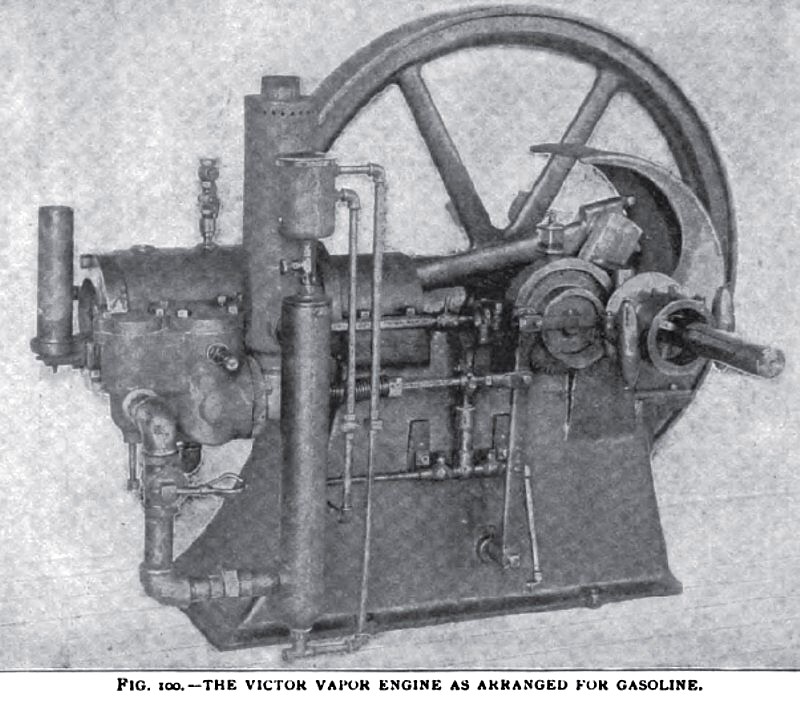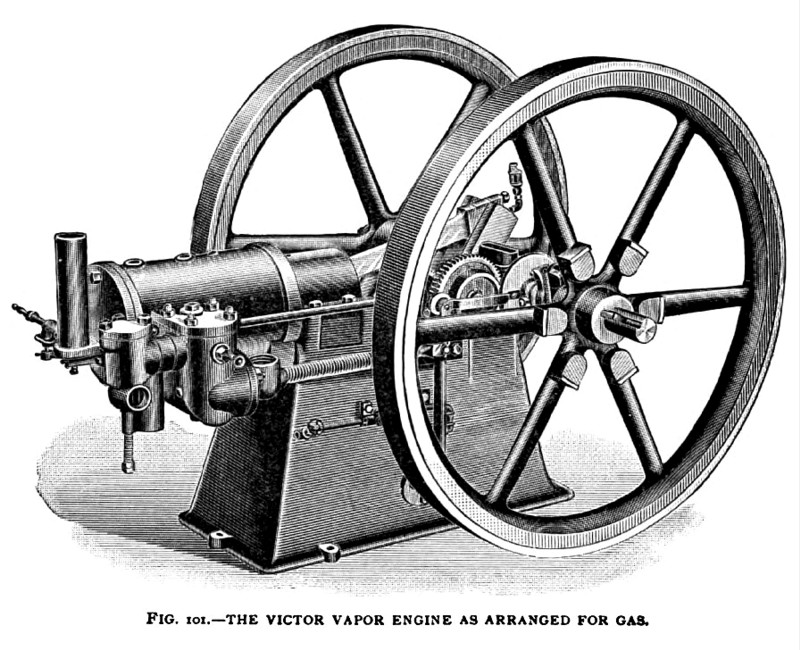|
Title: |
1898 Image-Thomas Kane & Co., Victor Vapor Engine |
|
Source: |
Gas, Gasoline and Oil Vapor Engines, 1898 pgs. 169 & 171 |
|
Insert Date: |
10/22/2012 7:40:28 PM |
Thomas Kane & Co.
The engines of Thomas Kane & Co., are of the four-cycle compression type, with poppet valves, ignition by hot tubes or electric battery and double sparking-coil.
Fig. 100 is a view of the engine as fitted for gasoline with hot-tube igniter, with one fly-wheel off to show the arrangement of the valve gear. A cam on the secondary gear drives the push-rod lever of the exhaust valve, which is held back by a spiral spring. The governor is of the horizontal centrifugal type, revolving on the main shaft, and by over-speed carries the roller of the push-rod lever on to the governor eccentric, holding the exhaust valve open.
The gasoline pump forces the gasoline into a small cup over the vaporizer, with an overflow back to the gasoline tank. The gasoline is fed to the vaporizer by a small valve and sight-feed cup, and comes in contact with the hot air drawn from the exhaust heater, which is a casing placed around the exhaust pipe and connected with the vaporizer by a side neck at the top of the vaporizer.
Thus the gasoline coming in contact with the hot air from the heater on extended surfaces inside of the vaporizer is completely vaporized and mixed with the air to saturation before it enters the admission valve, which opens by the suction of the piston.
Any accidental surplus of gasoline that may enter the vaporizer will drop into an extension of the vaporizer below the engine feed pipe, and flow back to the gasoline tank. An indexed regulating valve in the vapor pipe near the admission valve serves to regulate the flow of saturated vapor to the admission valve, where it is mixed with a further portion of air drawn in by the piston to make a proper explosive mixture.
The electric igniter is entered through the walls of the exhaust-valve chamber, which is directly connected with the inlet-valve chamber. It makes a double spark by a revolving mechanism driven from the secondary gear wheel and is adjustable, so that a spark takes place, one just before and one just after final compression—this being one of the peculiar features of this engine, from which a high efficiency is claimed; the other being the thin cylinder walls, as devised by Mr. Pennington.
In Fig. 101 the same engine is shown ready for gas connection, the operation of which is the same as for gasoline, as far as the valve action and regulation is concerned.
The sizes of the "Victor" are at present of 2. 3¾, and 5 B. H. P. |
|
 1898 Thomas Kane & Co., Victor Vapor Engine
1898 Thomas Kane & Co., Victor Vapor Engine
 1898 Thomas Kane & Co., Victor Vapor Engine
1898 Thomas Kane & Co., Victor Vapor Engine
|
|